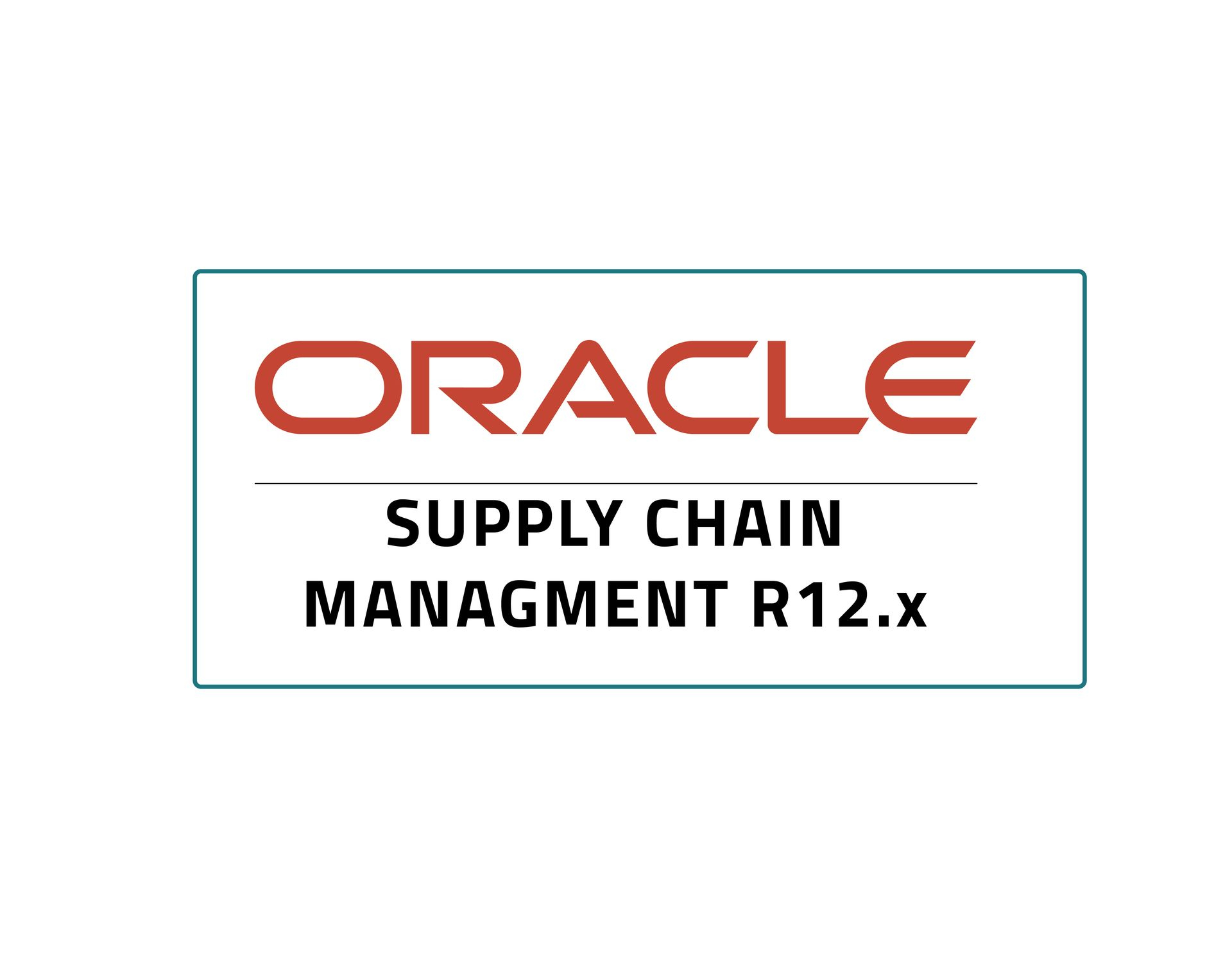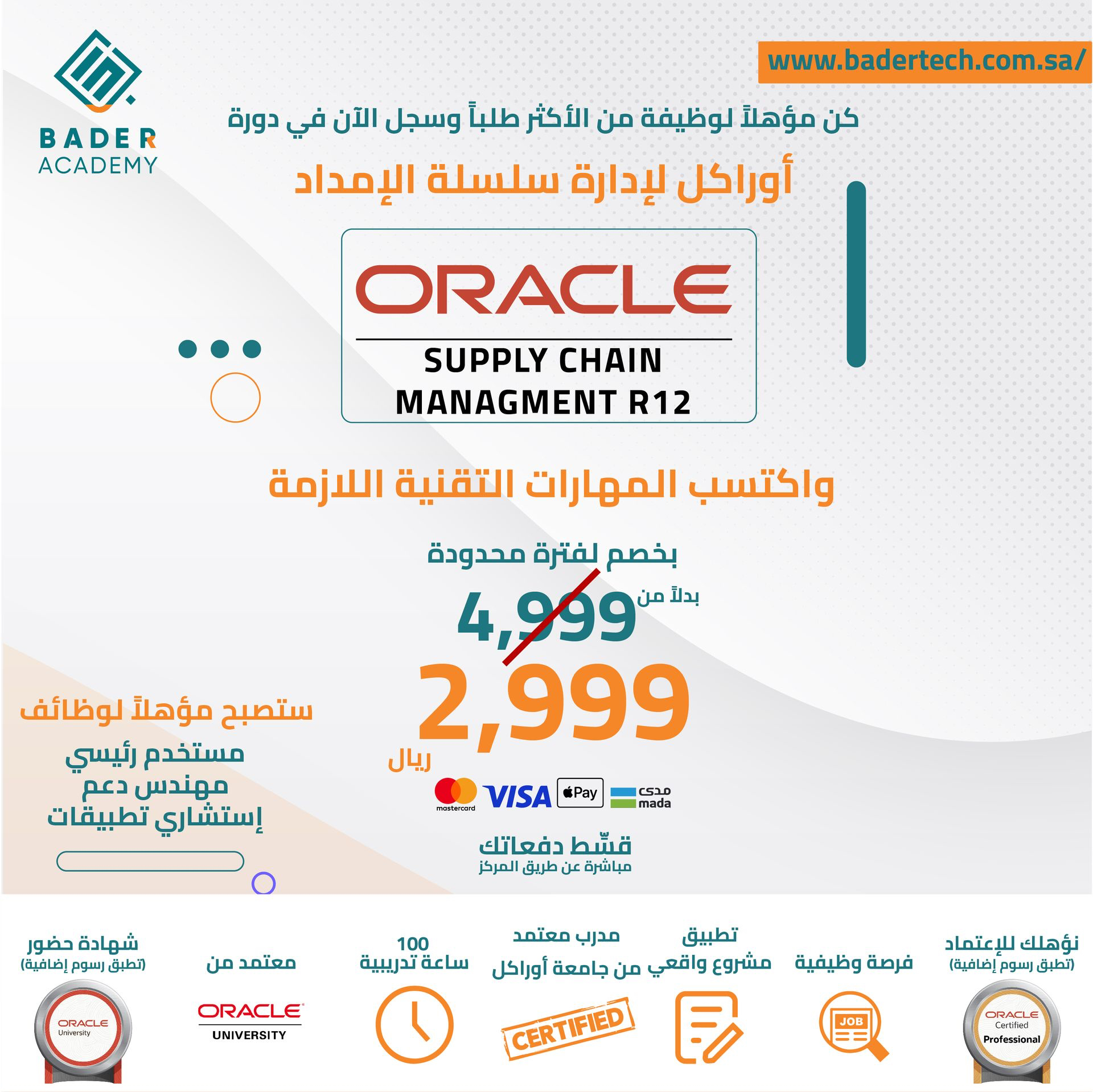
Oracle e-Business R12 SCM
$ 799.84
799.84
USD
$ 4,346.96
| Responsible | Bader Tech |
|---|---|
| Last Update | 03/Sep/2023 |
| Members | 15 |
Advanced

Overview
This course allows students to learn how to configure, set up, and utilize
Oracle Supply Chain Management (SCM) and Oracle Process Manufacturing (OPM) in order to plan and manage the entire of procurement, sales, and production business flows.
The objective of an Oracle R12 SCM and OPM course is to provide participants with the necessary knowledge and skills to effectively manage and optimize supply chain including manufacturing processes using Oracle E-Business Suite R12.
Course Includes
120 Hours Live Sessions
24/7 Support
One-on-One Doubt Clearing
Realtime Project Use Cases
Free Training Instance
Oracle Attendance Certification
Course Topics
Essentials For Implementers
- Navigating in R12 Oracle Applications
• Logon and off of Oracle Applications
• Using forms & menus
• Entering data using forms
• Searching forms
• Accessing Online Help - Introduction to R12 Oracle Applications
• Introduction to R12 Footprint
• Benefits of R12 Footprint
• R12 E-Business Suite Architecture
• Basic Technical Architecture
• Overview of Oracle file system and directories - Shared Entities and Integration
• Shared entities and Non-key shared entities
• Overview of E-Business Suite business flows and Integration - Fundamentals of System Administration
• Application Security Overview
• Function Security
• Data Security
• Profile Options
• Standard request submission (SRS) - Fundamentals of Flexfields
• Basics of Flexfields
• Define Value sets
• Define Key Flexfields
• Define Descriptive Flexfields
• Flex field enhancements in R12 - Fundamentals of Multiple-Organization and Multiple-Organization Access Control (MOAC)
• Introduction to Multiple-Organization and Multiple- Organization Access control (MOAC)
• Types of organizations supported in the Multi-Org model
• Multiple-Organization Access Control Setup and Process
• Reporting across entities
• Key Implementation consideration - Fundamentals of Oracle Work-flow & Alerts
• Overview of Work-flow
• Oracle Work-flow Home Pages
• Work-list Webpages
• Work-flow Monitor Webpages
• Overview of Alerts
• Difference between work-flows & alerts
Oracle Inventory Management
- Overview of Oracle Inventory
• Receiving Inventory
• Transferring Inventory
• On-hand and Availability
• Issuing Inventory
• Inventory Accuracy
• Discussing Inventory Application Integration - Inventory Structure
• Overview of Inventory Structure
• Setting up the Inventory Organization Structure
• Defining Organization Parameters
• Defining Shipping Networks
• Defining Sub inventories and Locators - Units of Measure
• Defining Units of Measure - Defining and Maintaining Items
• Defining Items Process
• Using Item Templates
• Assigning Items to Organizations
• Categories, Category Sets, and Catalogs
• Deleting Items - Lot and Serial Control
• Setting up Lot Control
• Maintaining Serial Information
• Maintaining Lot and Serial Genealogy - Transaction Setup
• Defining Transaction Types
• Defining Picking Rules
• Defining Account Aliases
• Opening and Closing Accounting Periods
• Setting up Move Orders
• Material Shortage Alerts and Notifications - Issuing and Transferring Material
• Managing Receipts
• Performing Transactions
• Performing Move Orders
• Performing Mobile Transactions
• Managing Shipments - On-hand and Availability
• Using the Material Workbench
• Creating Available to Promise Rules
• Managing Reservations - Material Status Control
• Material Status Setup - Inventory Replenishment
• Defining Replenishment
• Inventory Forecasting Methods
• Replenishment Counting
• Kanban - Inventory Accuracy
• Defining Counting
• ABC Analysis
• Cycle Counting
• Physical Inventory
Oracle Purchasing
- Procure To Pay Lifecycle Overview
• Procure to Pay Lifecycle
• Overview of Purchasing Process
• Integration with other Oracle Applications - Suppliers
• Overview of Suppliers
• Supplier Information
• Supplier Site Information
• Managing Suppliers
• Reports
• Financial Options
• Profile Options - Requisitions
• Requisition Lifecycle
• Notifications
• Requisition Structure
• Creating and Maintaining Requisitions
• Supplier Item Catalog
• Requisition Templates
• Reports
• Profile Options - RFQs and Quotations
• Request for Quotation Lifecycle
• Creating and Maintaining Requests for Quotation
• Creating a Supplier List
• Quotations Lifecycle
• Creating and Maintaining Quotations
• Reports
• Profile Options - Purchase Orders
• Purchase Order Types
• Purchase Order Components and Record Structure
• Standard Purchase Order Elements
• Contract Purchase Agreements
• Purchase Order Revisions
• Workflow Notifications
• Reports - Receiving
• Receiving Locations
• Receipt Routing
• Receipt Processing Methods
• Receiving Tolerances
• Entering Returns and Corrections
• Overview of Pay on Receipt
• Reports
• Profile Options - Professional Buyer’s Work Center
• Business Benefits of the Buyer’s Work Center
• Requisitions in the Buyer’s Work Center
• Standard Purchase Orders in the Buyer’s Work Center
• Purchase Agreements in the Buyer’s Work Center
• Setup
• Implementation Considerations - Document Security, Routing and
Approval
• Document Security and Access Levels
• Document Approval - Jobs and Positions
• Position Approval Hierarchies
• Document Types
• Creating Approval Groups
• Reports
• Workflow - Approved Supplier Lists and
Sourcing Rules
• Approved Supplier Lists
• Supplier Statuses
• Supplier-Commodity/Item Attributes
• Sourcing Rules
• Profile Options
Oracle Order Management
- Overview of Oracle Order Management
• Overview of Oracle Order Management
• What is Oracle Order Management?
• Order Capture and Order Fulfillment
• Oracle Order Management Capabilities
• Order to Cash Lifecycle
• Integration with Other Products - Order Entities and Order Flows
• Order to Cash Lifecycle with Standard Items
• Order to Cash Lifecycle with PTO Models and PTO Kits
• Drop Shipments
• Back-to-Back Orders
• Sales Agreements
• Negotiation Agreement
• Approve Sales Agreement - Oracle Receivables Setup for Oracle Order Management
• Overview of Trading Community Architecture
• Key Customer Related Concepts in TCA
• Adding Customers in Order Management
• Defining Payment Terms - Oracle Order Management Setup Steps
• Overview of Quick Code or Lookup Types
• Overview of Transaction Types Window
• Workflow in Transaction Types
• Defining Defaulting Rules
• Auto-Schedule Profile Option
• Defining Credit Usage Rule Sets - Basic Pricing Setup
• Overview of Pricing in the Order to Cash Process
• Creating a Price List
• Add Items to Price List
• Implementation Steps: Setting Key Profile Options - Overview of Shipping Execution
• Shipping Execution Flow
• Delivery and Delivery Lines
• Trips and Stops
• Delivery Leg
• Ship Confirm - Shipping Execution Setup
• Granting Roles To Users
• Running Pick Release
• Pick Slip Grouping Rule
• Auto create Deliveries
• Release Sales Orders for Picking Window
Oracle Process Manufacturing
- R12 Oracle Process Manufacturing Product Development
• Set up Product Development
• Create and maintain formulas
• Define and maintain operations
• Define and maintain routings
• Create recipes
• Use the routing and recipe designer - R12 Oracle Process Manufacturing Process Execution
• Set up Process Execution
• Create and edit firm planned orders and batches
• Convert firm planned orders into single or multiple production batches
• Schedule production batches
• Reserve ingredients and products in batch production
• Process production batches
• Move material to production staging area
• Record actual ingredient usage
• Perform ingredient picking
• Record actual resource usage
• Reopen, unrelease, cancel, and terminate batches
• Complete and close production batches
• Record actual product production quantities - R12 Oracle Process Manufacturing Cost Management
• Understand the OPM Cost Management Application
• Set Up OPM Cost Management
• Use Standard Costs
• Use Actual Costs
• Use Lot Costs
• Perform Period-end Cost Processing
• Copy Costs
• Run Cost Management Reports
• Use Sub-ledger Accounting and Processes